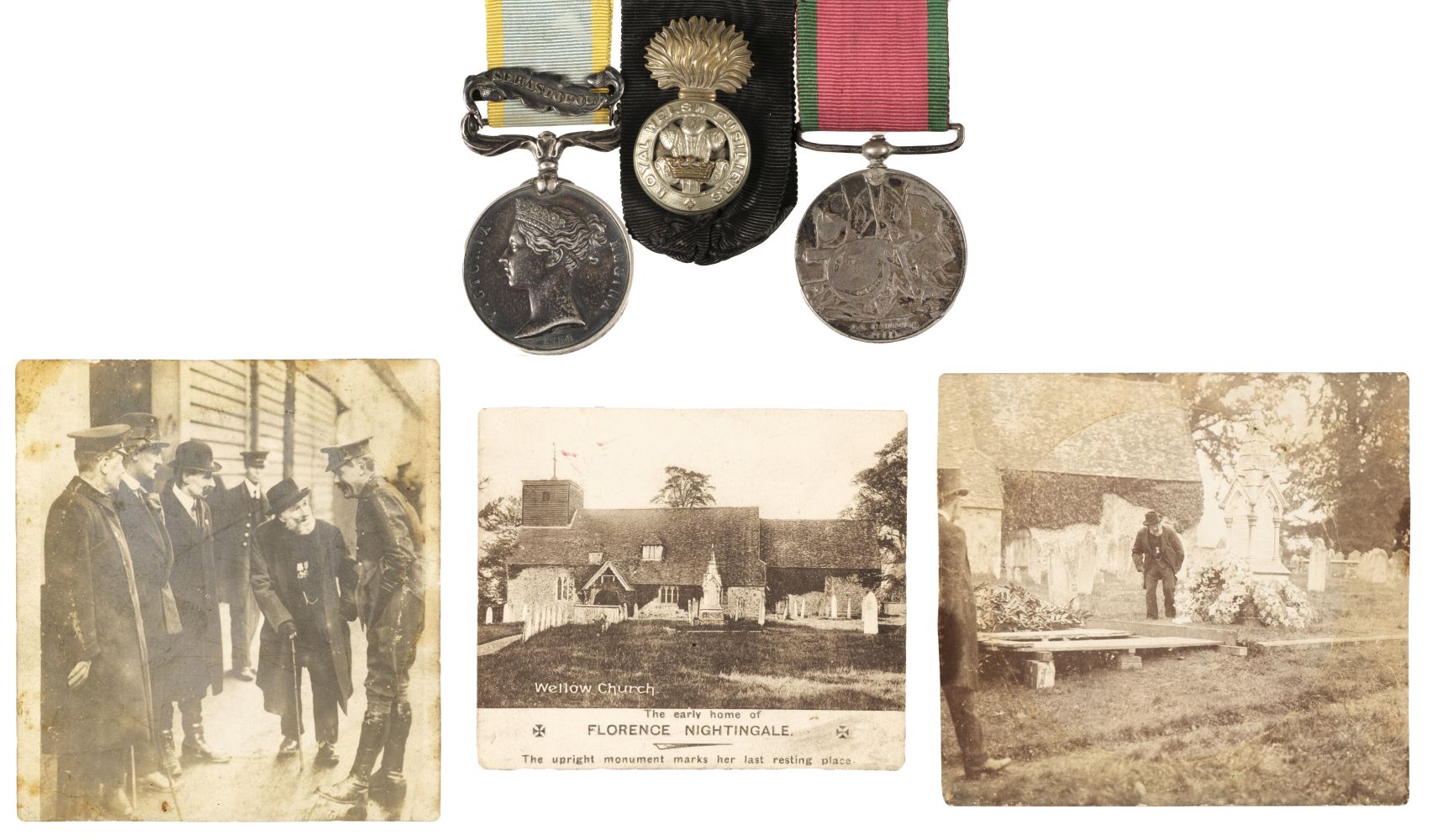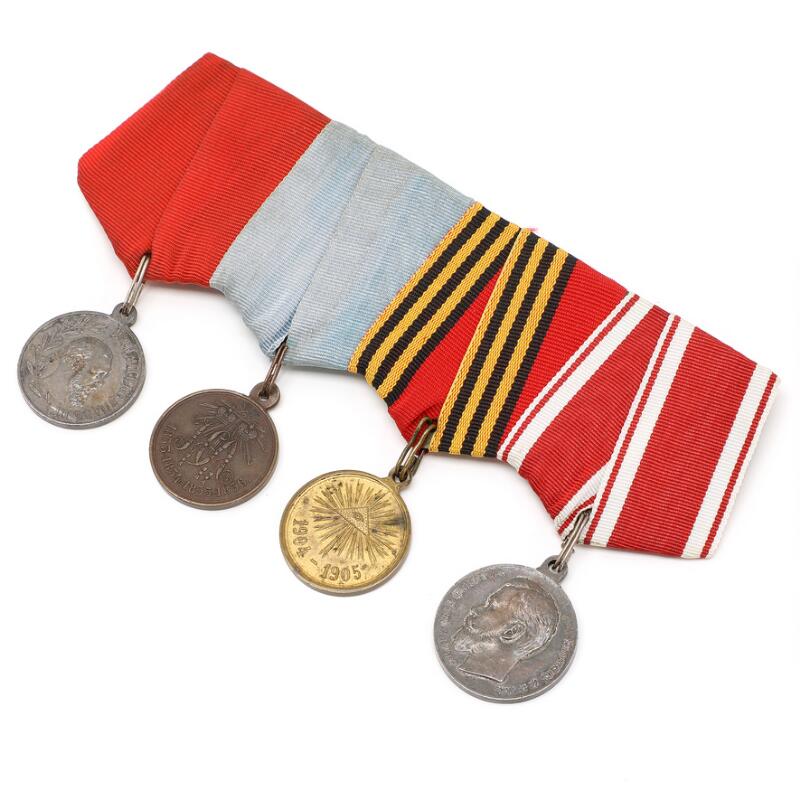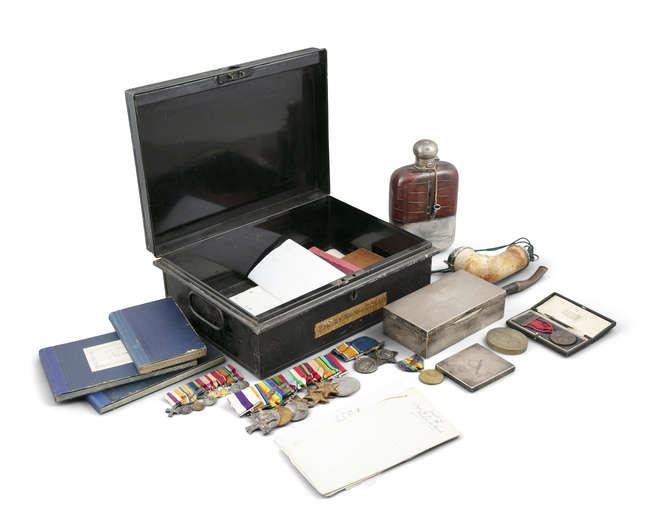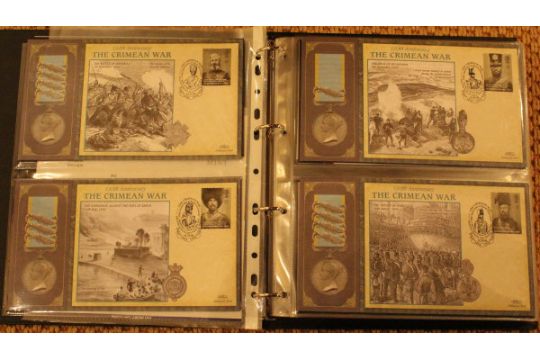Crimean War. The medals, uniform, personal effects and memorabilia of Captain Anthony Morgan (1830-1907), comprising Crimea Medal, three clasps, Alma, Inkermann and Sebastopol with original silver buckle, Lieut Morgan 95th Foot and Turkish Crimea Medal, British Issue, officer's great coat with shoulder cape and velvet collar, cap cover, officer’s 1844 (1st Albert) pattern shako complete with plate to 95th (The Derbyshire) Regt, Grenadier Officer's undress forage cap named 'A Morgan 95th', white, grenadier’s, woollen, ball tuft, Grenadier subaltern's coatee 1844 pattern (lacks RH wing which was pierced by gunfire at The Alma), Grenadier's sash, sword belt, black leather sword belt, sword belt plate, mess dress waistcoat, Infantry Officer's sword and steel scabbard, 1822 pattern, inscribed A Morgan 95th Regt Alma Sortie 26th October Inkermann and Sebastopol, French Light Cavalry Sabre, 1822 pattern recovered from the Field of Balaklava, photograph of Captain Morgan after presentation of medals, London 1855, clay pipe with silver band inscribed A Morgan 95th Regiment Alma Sortie 26th October, Inkermann, Sebastopol, another uninscribed, leather cigar case embossed royal arms and inscribed in ink A Morgan Capt 95th Regt, clasp knife, crested and initialled, used when assisting the grievously wounded Captain Heyland at The Alma, silver teaspoon carried in the Crimea, Morgan crest, three photographs (mounted whole plate albumen prints) of officers and other ranks, 95th Regiment at Beggar's Bush Barracks Dublin, 1856, handwritten captions, quarter plate (9.5 x 7cm) daguerreotype of Captain Morgan, correspondence to Morgan, all autograph letters signed 1855-1857, including Commanding Officer 95th Regiment, Dublin, explaining why Morgan would not be recommended for a Victoria Cross, crucifix recovered from Inkermann by Captain Morgan with handwritten label signed by Edward Morgan 1937, mostly in the Edwardian wall hanging mahogany display case from Captain Morgan's study at Bunalun, Skibbereen Co Cork The accompanying contemporary press cutting provides facts and interesting details of Captain Morgan's military career: "Captain Anthony Morgan sailed from England for Turkey in April 1854 with the 95th, being then fourth Senior Subaltern of the Battalion and Senior Subaltern of the Grenadier Company commanded by Captain Eddington. At the Battle of The Alma he bore himself right manfully, and in the storm and stress of the fight did no little execution with a Minie rifle taken from a fallen comrade. On the left bank of the river he was handed by Major Hume the queen's Colour which he carried during the remainder of the action. He was present at the Repulse of the Russian sortie of the 26th October, and led a body of the 95th in pursuit of the Muscovites, almost up to the walls of the Fortress of Sebastopol, incurring the wrath of the plainspoken Pennefather for the small notice he had taken of the 'Retire'... On the night of the 4th November and having been relieved on the following morning, [he] was returning to camp when the fight broke out behind him and he returned to the front. He was one of the few who got through the day untouched... He left the Crimea, retiring in 1857." It is pleasant to read of the estimation in which he is held by his old comrades, 'Morgan was a fine, tall, athletic fellow, and the best all round sportsman I ever met'. The Colour carried by Morgan was struck twice while in his charge, a shot going through his wing and hitting in the throat Private Keenan. (This man made a complete recovery.) Morgan had noticed the Russian sharp-shooter who had just fired, and taking a rifle from one of the men behind him, Morgan, who was a splendid shot, killed the Russian. The next day Morgan was sent for by Major Hume, when the following conversation ensued: — "Morgan, do you think you were justified in shooting that Russian yesterday?" ''I think I was, sir." ''I think you were not; it is not the duty of an officer. You should
Crimean War. The medals, uniform, personal effects and memorabilia of Captain Anthony Morgan (1830-1907), comprising Crimea Medal, three clasps, Alma, Inkermann and Sebastopol with original silver buckle, Lieut Morgan 95th Foot and Turkish Crimea Medal, British Issue, officer's great coat with shoulder cape and velvet collar, cap cover, officer’s 1844 (1st Albert) pattern shako complete with plate to 95th (The Derbyshire) Regt, Grenadier Officer's undress forage cap named 'A Morgan 95th', white, grenadier’s, woollen, ball tuft, Grenadier subaltern's coatee 1844 pattern (lacks RH wing which was pierced by gunfire at The Alma), Grenadier's sash, sword belt, black leather sword belt, sword belt plate, mess dress waistcoat, Infantry Officer's sword and steel scabbard, 1822 pattern, inscribed A Morgan 95th Regt Alma Sortie 26th October Inkermann and Sebastopol, French Light Cavalry Sabre, 1822 pattern recovered from the Field of Balaklava, photograph of Captain Morgan after presentation of medals, London 1855, clay pipe with silver band inscribed A Morgan 95th Regiment Alma Sortie 26th October, Inkermann, Sebastopol, another uninscribed, leather cigar case embossed royal arms and inscribed in ink A Morgan Capt 95th Regt, clasp knife, crested and initialled, used when assisting the grievously wounded Captain Heyland at The Alma, silver teaspoon carried in the Crimea, Morgan crest, three photographs (mounted whole plate albumen prints) of officers and other ranks, 95th Regiment at Beggar's Bush Barracks Dublin, 1856, handwritten captions, quarter plate (9.5 x 7cm) daguerreotype of Captain Morgan, correspondence to Morgan, all autograph letters signed 1855-1857, including Commanding Officer 95th Regiment, Dublin, explaining why Morgan would not be recommended for a Victoria Cross, crucifix recovered from Inkermann by Captain Morgan with handwritten label signed by Edward Morgan 1937, mostly in the Edwardian wall hanging mahogany display case from Captain Morgan's study at Bunalun, Skibbereen Co Cork The accompanying contemporary press cutting provides facts and interesting details of Captain Morgan's military career: "Captain Anthony Morgan sailed from England for Turkey in April 1854 with the 95th, being then fourth Senior Subaltern of the Battalion and Senior Subaltern of the Grenadier Company commanded by Captain Eddington. At the Battle of The Alma he bore himself right manfully, and in the storm and stress of the fight did no little execution with a Minie rifle taken from a fallen comrade. On the left bank of the river he was handed by Major Hume the queen's Colour which he carried during the remainder of the action. He was present at the Repulse of the Russian sortie of the 26th October, and led a body of the 95th in pursuit of the Muscovites, almost up to the walls of the Fortress of Sebastopol, incurring the wrath of the plainspoken Pennefather for the small notice he had taken of the 'Retire'... On the night of the 4th November and having been relieved on the following morning, [he] was returning to camp when the fight broke out behind him and he returned to the front. He was one of the few who got through the day untouched... He left the Crimea, retiring in 1857." It is pleasant to read of the estimation in which he is held by his old comrades, 'Morgan was a fine, tall, athletic fellow, and the best all round sportsman I ever met'. The Colour carried by Morgan was struck twice while in his charge, a shot going through his wing and hitting in the throat Private Keenan. (This man made a complete recovery.) Morgan had noticed the Russian sharp-shooter who had just fired, and taking a rifle from one of the men behind him, Morgan, who was a splendid shot, killed the Russian. The next day Morgan was sent for by Major Hume, when the following conversation ensued: — "Morgan, do you think you were justified in shooting that Russian yesterday?" ''I think I was, sir." ''I think you were not; it is not the duty of an officer. You should









/65729/Internet%20Image%201.jpg)





Testen Sie LotSearch und seine Premium-Features 7 Tage - ohne Kosten!
Lassen Sie sich automatisch über neue Objekte in kommenden Auktionen benachrichtigen.
Suchauftrag anlegen